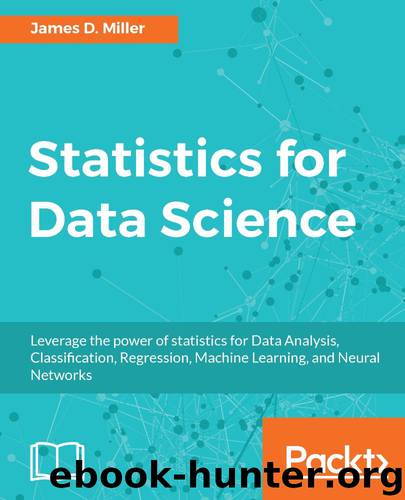Statistics for Data Science: Leverage the power of statistics for Data Analysis, Classification, Regression, Machine Learning, and Neural Networks by James D. Miller

Author:James D. Miller [Miller, James D.]
Language: eng
Format: epub
Tags: COM037000 - COMPUTERS / Machine Theory, COM018000 - COMPUTERS / Data Processing, COM077000 - COMPUTERS / Mathematical and Statistical Software
Publisher: Packt Publishing
Published: 2017-11-17T00:00:00+00:00
Introducing statistical regression
As promised, let's get going in this chapter with a section that provides a clear explanation of what statistical regression is.
For starters, statistical regression is also routinely referred to as regression analysis and is a process for estimating the relationships among variables. This process encompasses numerous techniques for modeling and analyzing variables, focusing on the relationship between a dependent variable and one (or more) independent variables (or predictors).
So specifically, regression analysis is the work done to identify and understand how the (best representative) value of a dependent variable (a variable that depends on other factors) changes when any one of the independent variables (a variable that stands alone and isn't changed by the other variables) is changed while the other independent variables stay the same.
A simple example might be how the total dollars spent on marketing (an independent variable example) impacts the total sales dollars (a dependent variable example) over a period of time (is it really as simple as more marketing equates to higher sales?), or perhaps there is a correlation between the total marketing dollars spent (independent variable), discounting a products price (another independent variable), and the amount of sales (a dependent variable)?
Keep in mind this key point that regression analysis is used to understand which among the independent variables are related to the dependent variable(s), not just the relationship of these variables. Also, the inference of causal relationships (between the independent and dependent variables) is an important objective. However, this can lead to illusions or false relationships, so caution is recommended!
Overall, regression analysis can be thought of as estimating the conditional expectations of the value of the dependent variable, given the independent variables being observed, that is, endeavoring to predict the average value of the dependent variable when the independent variables are set to certain values. I call this the lever affect—meaning when one increases or decreases a value of one component, it directly affects the value at least one other (variable).
An alternate objective of the process of regression analysis is the establishment of location parameters or the quantile of a distribution. In other words, this idea is to determine values that may be a cutoff, dividing a range of a probability distribution values.
You'll find that regression analysis can be a great tool for prediction and forecasting (not just complex machine learning applications). We'll explore some real-world examples later, but for now, let's us look at some techniques for the process.
Download
This site does not store any files on its server. We only index and link to content provided by other sites. Please contact the content providers to delete copyright contents if any and email us, we'll remove relevant links or contents immediately.
Sass and Compass in Action by Wynn Netherland Nathan Weizenbaum Chris Eppstein Brandon Mathis(7967)
Supercharging Productivity with Trello by Brittany Joiner(7324)
Mastering Tableau 2023 - Fourth Edition by Marleen Meier(7091)
Inkscape by Example by István Szép(6963)
Secrets of the JavaScript Ninja by John Resig Bear Bibeault(6736)
Visualize Complex Processes with Microsoft Visio by David J Parker & Šenaj Lelić(6644)
Build Stunning Real-time VFX with Unreal Engine 5 by Hrishikesh Andurlekar(5672)
Design Made Easy with Inkscape by Christopher Rogers(4995)
Customizing Microsoft Teams by Gopi Kondameda(4537)
Business Intelligence Career Master Plan by Eduardo Chavez & Danny Moncada(4435)
Extending Microsoft Power Apps with Power Apps Component Framework by Danish Naglekar(4149)
Salesforce Platform Enterprise Architecture - Fourth Edition by Andrew Fawcett(4012)
Linux Device Driver Development Cookbook by Rodolfo Giometti(4008)
Pandas Cookbook by Theodore Petrou(4001)
The Tableau Workshop by Sumit Gupta Sylvester Pinto Shweta Sankhe-Savale JC Gillet and Kenneth Michael Cherven(3815)
Exploring Microsoft Excel's Hidden Treasures by David Ringstrom(3289)
TCP IP by Todd Lammle(3117)
Applied Predictive Modeling by Max Kuhn & Kjell Johnson(3006)
Drawing Shortcuts: Developing Quick Drawing Skills Using Today's Technology by Leggitt Jim(2975)
